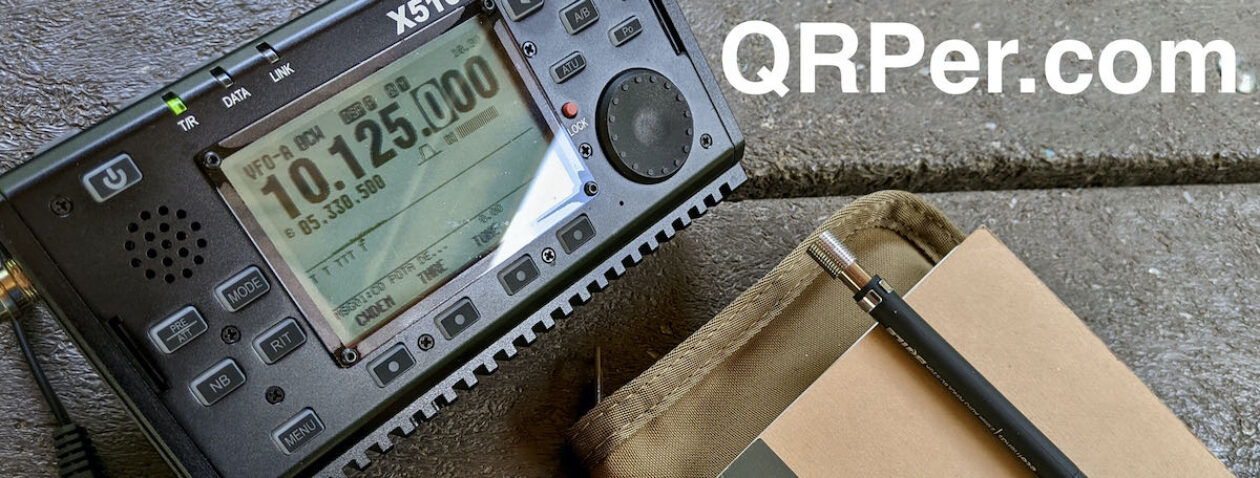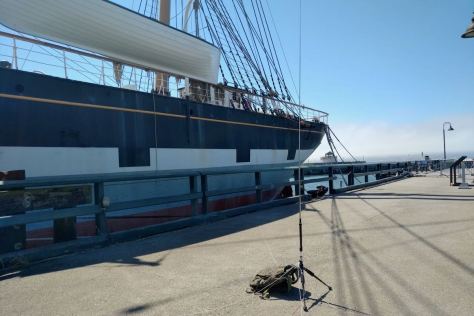Many thanks to Matt (W6CSN) who shares the following post from his blog at W6CSN.Blog:
Fort Baker On The Air
by Matt (W6CSN)
Fort Baker is a former U.S. Army post situated at the north of side of the Golden Gate, opposite Fort Point and adjacent the town of Sausalito, California. The post is now part of the sprawling Golden Gate National Recreation Area (GGNRA) which is also known as K-0647 for POTA.
Many of the good POTA spots in the GGNRA are heavily used for recreation and sightseeing on weekend days such as this, but Cavallo Point is out of the way enough that there was still ample, free parking today. This location offers spectacular views of the Golden Gate Bridge, the city of San Francisco, and Alcatraz and Angel Islands at anchor in San Francisco Bay.
 Today the “pull of POTA” was strong as I wanted to get another activation done before the arrival of an anticipated solar storm as well as rains predicted for the coming week.
Today the “pull of POTA” was strong as I wanted to get another activation done before the arrival of an anticipated solar storm as well as rains predicted for the coming week.
 During the week leading up to this activation the Bay Area has experienced fine weather with mild daytime temperatures and light winds, but driving in, the sound of rigging slapping loudly against the aluminum masts of the sailboats docked in the Presidio Yacht Club marina told me that it was windy down here.
During the week leading up to this activation the Bay Area has experienced fine weather with mild daytime temperatures and light winds, but driving in, the sound of rigging slapping loudly against the aluminum masts of the sailboats docked in the Presidio Yacht Club marina told me that it was windy down here.
 A short series of wooden staircases lead up from the parking area to Battery Yates, named for Captain George Yates of the U.S. Cavalry who fell in the Battle of Little Big Horn in 1876.
A short series of wooden staircases lead up from the parking area to Battery Yates, named for Captain George Yates of the U.S. Cavalry who fell in the Battle of Little Big Horn in 1876.
 The gun battery is a reinforced concrete structure which once sported six rifles that fired a three inch caliber cartridge to provide for naval defense inside of San Francisco Bay. The guns were manned through the middle of World War Two when, by 1943, they had been moved to more strategic locations.
The gun battery is a reinforced concrete structure which once sported six rifles that fired a three inch caliber cartridge to provide for naval defense inside of San Francisco Bay. The guns were manned through the middle of World War Two when, by 1943, they had been moved to more strategic locations.
 Today I had hoped to use the same steel pipe which supported a fiberglass mast and EFHW in an earlier activation from this spot, but unfortunately the pipe was too thick to get the jaw mount securely attached.
Today I had hoped to use the same steel pipe which supported a fiberglass mast and EFHW in an earlier activation from this spot, but unfortunately the pipe was too thick to get the jaw mount securely attached.
 I went with plan B which was to use the pipe railing at the back edge of the gun pit. Being unsure whether or not the galvanized steel railing made any electrical connection to what surely must be rebar embedded in the concrete, I deployed the 17 foot vertical whip with three radials just in case.
I went with plan B which was to use the pipe railing at the back edge of the gun pit. Being unsure whether or not the galvanized steel railing made any electrical connection to what surely must be rebar embedded in the concrete, I deployed the 17 foot vertical whip with three radials just in case.
 Whatever was serving as a counterpoise, it was doing a great job, providing an SWR reading of 1.0 to 1 on the Mountaintopper MTR-4B. This was probably the third activation on this Lithium-Ion battery pack, so the power was down to 3.7 watts, still plenty for a CW activation with a resonant antenna.
Whatever was serving as a counterpoise, it was doing a great job, providing an SWR reading of 1.0 to 1 on the Mountaintopper MTR-4B. This was probably the third activation on this Lithium-Ion battery pack, so the power was down to 3.7 watts, still plenty for a CW activation with a resonant antenna.
 The activation was scheduled ahead of time on the POTA web application so all I had to do was just start calling CQ POTA and let the RBN do the spotting. I soon heard from KG6HM from right across the Bay, followed by stations from Washington, Idaho, Utah, Arizona, and New Mexico.
The activation was scheduled ahead of time on the POTA web application so all I had to do was just start calling CQ POTA and let the RBN do the spotting. I soon heard from KG6HM from right across the Bay, followed by stations from Washington, Idaho, Utah, Arizona, and New Mexico.
 I was starting to think it would be only western states calling in, but the band opened up a bit, bringing N3RT from Delaware. Now we had a proper coast-to-coast activation, and, I bagged a hard-to-get state needed for an informal CW “Worked-All-States” achievement.
I was starting to think it would be only western states calling in, but the band opened up a bit, bringing N3RT from Delaware. Now we had a proper coast-to-coast activation, and, I bagged a hard-to-get state needed for an informal CW “Worked-All-States” achievement.
 By this time, the wind really started to pick up and with the sun so low in the western sky, it was becoming chilly. Satisfied with the 14 QSOs in the log, we packed up, made our way back down the pathway to the car, and then to a fancy coffee house in Sausalito for a nice warm cup.
By this time, the wind really started to pick up and with the sun so low in the western sky, it was becoming chilly. Satisfied with the 14 QSOs in the log, we packed up, made our way back down the pathway to the car, and then to a fancy coffee house in Sausalito for a nice warm cup.
- Mountaintopper MTR-4B v2 by LNR Precision
- Talentcell 3000 maH 12v Li-Ion battery pack
- ABR RG-316 coax feedline with ferrite common-mode choke
- MFJ-1979 telescoping whip from DX Engineering
- Quick release mirror mount with 3/8×24 to SO-239 adapter
- N0SA SP4 Morse paddles by CWMORSE.US
- MUJI Notebook for logging
- ZEBRA mechanical pencil for logging (the “shock absorber” spring makes this great for field use)
- Various Maxpedition Gear pocket organizers
73 de W6CSN





































